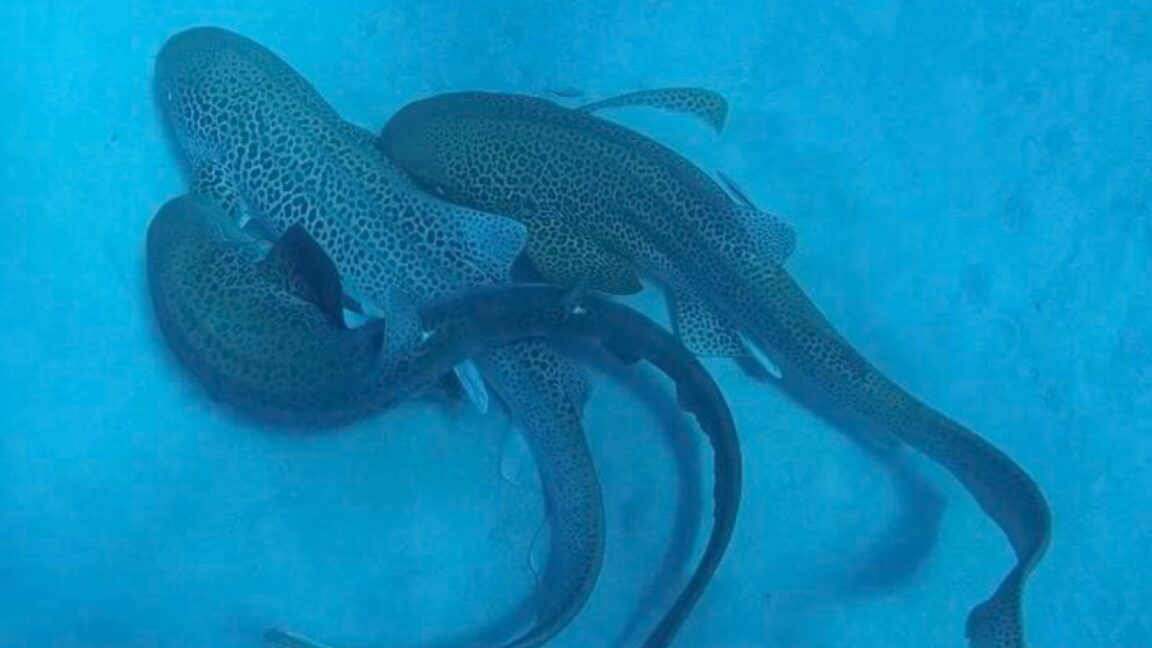Researchers from the University of the Sunshine Coast (UniSC) in Australia have made a groundbreaking discovery by capturing on video a rare mating sequence involving three leopard sharks—two males and one female—off the coast of Nouméa, New Caledonia. This event, documented in the Journal of Ethology, marks the first time such behavior has been observed in the wild, providing valuable insights into the mating habits of this endangered species.
Leopard sharks are notorious for their elusive mating rituals, with much of the existing knowledge derived from observations in captivity. The recent footage allows scientists to compare and contrast these behaviors with those observed in natural habitats. The lead researcher, Hugo Lassauce, has been snorkeling daily with sharks for a year as part of a monitoring program in the region. His dedication to studying these creatures finally paid off when he witnessed the mating sequence firsthand.
While observing the sharks, Lassauce noticed a female resting on the seabed, attended by two males displaying typical pre-copulation behavior. He and his colleagues decided to minimize disturbances by moving their boat away. “I waited an hour, freezing in the water, but finally they started swimming up,” Lassauce recounted. The mating itself was swift, with the first male completing his act in 63 seconds and the second in 47 seconds. Afterward, the male sharks lay motionless on the sea floor while the female swam away.
The recording process was not without its challenges. Lassauce utilized two GoPro Hero 5 cameras, which faced battery limitations. The footage contains two interruptions—a result of the need to switch cameras and conserve battery life. Despite these issues, the team’s perseverance led to a successful documentation of this significant event. The excitement was palpable among his colleagues, who understood the rarity of what they had just captured.
The mating sequence itself involved an extended pre-copulation phase, with the three sharks remaining virtually motionless for nearly an hour. Once the female began to swim, the males engaged by biting onto her pectoral fins, a behavior observed in captivity. The first male then penetrated the female’s cloaca using his modified pelvic fin, known as a clasper, which is essential for sperm transfer. After the first male completed his mating, he became immobile, allowing the second male to take his turn.
This observation is not only scientifically significant but also highlights the importance of the region as a critical mating habitat for leopard sharks. Understanding these behaviors can inform conservation strategies and artificial insemination efforts aimed at “rewilding” leopard shark populations in Australia and other countries where they are threatened.
Co-author Christine Dudgeon remarked on the significance of the dual male involvement, stating, “From a genetic diversity perspective, we want to find out how many fathers contribute to the batches of eggs laid each year by females.” The findings from this research could pave the way for further studies on the reproductive habits of leopard sharks and contribute to their conservation.
This remarkable video documentation not only enriches the scientific understanding of leopard shark mating practices but also sheds light on the need for continued conservation efforts to protect this endangered species. The study exemplifies the potential of field observations to provide insights that are often unattainable in controlled environments.







































































